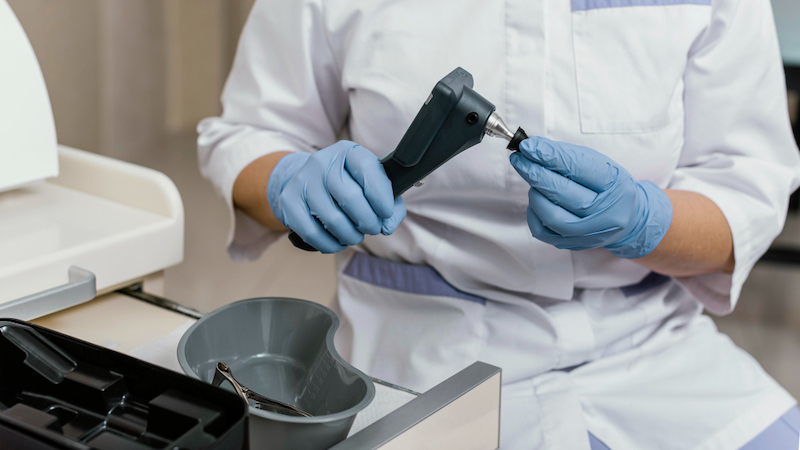Why Portable Spirometers Are Invaluable For DOT Examiners
For those who are or want to become a DOT certified medical examiner, having the right tools is crucial. They will allow you to accurately assess the health and fitness of the commercial drivers you see in your office. While you may already have many of these tools, others that provide unique insight needed during a DOT physical may not be in your arsenal just yet. One tool that you should have at your disposal is a portable spirometer. These small devices can give you important information about the respiratory health of each patient.
What Is A Spirometer?
Our lungs remove carbon dioxide and introduce oxygen into the bloodstream. The efficiency of this exchange is a great indicator of respiratory health and essential to the health and function of every system in the body. Healthy lungs aid in efficiently delivering oxygen to the muscles, heart, and brain, making performing daily tasks possible. If your patient’s lungs are obstructed, scarred, or not functioning correctly, they may feel winded, tired, weak, dizzy, and can pass out.
A spirometer measures how much air an individual can breathe in and out. It is one of the more effective tools for diagnosing lung dysfunction and disease. Spirometry testing can alert you to conditions such as asthma, chronic obstructive pulmonary disease (COPD), pulmonary fibrosis, and emphysema. It also helps monitor the efficacy of treatments for these lung conditions. It can alert you to improvement or backsliding in the patient’s condition.
How Does A Portable Unit Help Your Patients?
Of course, you can refer patients to the hospital for testing. So why is it better for your patients if you have a portable spirometer in your office?
- Time: Hospitals are busy places. They provide care for a wide variety of people and conditions. Scheduling and completing testing through a busy hospital can take weeks as there are many steps to the process.
- Scheduling the appointment
- Clearing the procedure with the patient’s insurance
- Clearing the procedure with the patient’s insurance
- Performing the test
- Analyzing the data
- Sending your office a report so you can schedule a follow-up appointment to review the results
- Convenience: If the patient has to travel far to complete testing at the hospital, a spirometer in your office will save them the gas, miles, and travel time.
- Money: If the patient takes time off work to get tested, they lose either money or vacation time. They may also have a copay for visiting another office and the cost for the procedure to cover.
- Health: Patients are less likely to contract a disease at a doctor’s office than at a hospital. Some patients, especially those with compromised lung function and immune systems, may avoid seeking medical treatment if it means going to the hospital. Hospitals treat more patients with serious medical conditions than a clinic or family doctor’s office.
How Does A Portable Unit Help Your Office?
In addition to the many benefits your patients will enjoy by coming directly to you for these services, there are some key benefits for your office.
- Premium: Rather than outsourcing these services, you can perform them in-house and make money while saving your patients money. It’s a good deal for everyone.
- Better Patient Care: Shortness of breath can be distressing as your patients try to function normally. Rather than taking weeks to diagnose and treat your patients, you can verify the severity of their respiratory distress and offer them appropriate treatment immediately.
- Quicker DOT Exams: There is always someone who forgets the deadline. They need a physical exam for commercial drivers to be employable. With a driver’s livelihood on the line, it is essential to get the DOT physical exam results necessary to clear them for duty as soon as possible so they can get back on the road.
Does The Spirometer Require Training?
Yes. As with most medical equipment, following proper testing techniques will help you get the most accurate results. You must also understand how to read the results to provide exemplary patient care. Here are some tips on how to get the best results:
- Good Posture: For the most accurate results, the patient must sit up straight with back support so they don’t hunch forward. This position limits lung capacity and may lead you to believe the patient has a smaller lung capacity.
- Rest Between Tests: Emptying their lungs into the spirometer can leave even healthy patients a little winded. Wait at least one minute between tests to allow the patient to catch their breath and return to their normal resting state.
- Perform The Test: Use a nose plug to prevent air from escaping through the nostrils. Have the patient breathe in as deeply as possible, hold it for one second, then breathe out as hard as possible through their mouth into the spirometer for six seconds.
- Pick The Right Result: You’re looking for two tests with the same results. Many factors skew the results. By waiting for two consistent tests, you can verify your results.
Are There Times When An In-Office Spirometer Test Is Contraindicated?
Despite the many benefits, there are times when it is inappropriate to perform the test in the clinic. Some of the conditions that make this test problematic are:
- Recent surgery
- A Recent Pneumothorax
- Respiratory Infection
- Intracranial Hypertension
- Pulmonary Embolism
- The patient cannot understand the instructions due to age, dementia, or cognitive disability.
Expanding Your Testing
A spirometer is an inexpensive way to enhance your view into the health and wellness of your patients during their DOT physical exam. Expanding your testing capabilities to offer patients in-office spirometry testing is a convenient way to save both you and your patients time. Performing the physical and necessary testing in one visit will be appealing to commercial drivers and can help you grow your practice as well.

